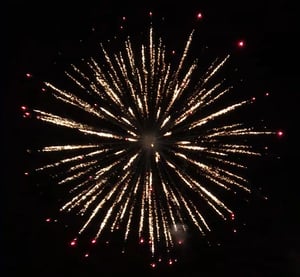Nearly 30 million children and teens play in an organized sport in the U.S. which leads nearly 3.5 million of those young athletes to injury each year. Student sports injuries account for almost one-third of all injuries incurred in childhood. Typically, the most common related injuries are sprains and strains with some sports, such as contact...
Public Safety on Independence Day
Its tradition in the U.S. to celebrate our nation's independence with pyrotechnics, but that tradition makes this holiday a busy time for healthcare providers tasked with responding to 911 calls for related injuries. Burns, eye trauma and other serious injuries are par for the course on the evening of the Fourth of July. Ensure you, your family and your friends stay safe by handling explosive products responsibly.
Professional Fireworks
Professional fireworks are created when black powder is mixed with other combustible elements such as sulfur, potassium or sodium; they’re arranged in layers that ignite in succession to produce a display of bright colors and sounds in spectacular patterns.
Professional fireworks, which you typically see at Fourth of July celebrations, are regulated by the Bureau of Alcohol, Tobacco, Firearms and Explosives (ATF) within the United States Department of Justice. These fireworks require a minimum clearance of 70 feet per 1-inch in diameter aerial shell. An easier way to calculate this safety requirement is rounding up to 100 feet of clearance for each inch of product; 300 feet for 3-inch product, 500 feet for 5-inch product, etc.
Knowing how fireworks work can help you understand the need for safety. A firework starts with the burning of a fuse. Once the fuse reaches the aerial shell, it ignites the bottom, known as the lift packet which simultaneously lights a timer fuse. This fuse burns as the aerial shell reaches an appropriate altitude and then explodes once it hits a break charge composed of a tightly packed ball of black powder. This explosion lights pellets, called stars, inside the aerial shell. These pellets are the part of the shell that produce colors.

Different chemical combinations produce different colors:
- Red - strontium salts and lithium salts
- White - magnesium or aluminum
- Blue - copper compounds and chlorine
Single break aerial shells are fired from securely positioned mortar racks. These "racks" consist of individual tubes where individual aerial shells are placed, in addition to required electrical or computer circuitry necessary for remote ignition. Professional shooting sites are operated by an onsite licensed pyrotechnic. Below is a brief overview of a shooting site:
- Fallout - area located directly under or near a shoot site where hazardous debris falls as a result of a pyrotechnic devise being fired
- Shell - contains a burst charge connected to an internal time fuse
- Mortar - a tube from which aerial shells are fired
- Rack - a frame which contains the mortar
Consumer Grade Fireworks
 Consumer grade firework products which you would find available for purchase at a firework stand are a much lower grade of explosive. Professional firework products tend to be safer due to required safety regulations, trainings and equipment. Most general consumers have a lack of knowledge and training when handling pyrotechnic products, making low-grade explosive products much more dangerous. In fact, the number one cause for emergency room visits are burns and injuries associated with sparklers.
Consumer grade firework products which you would find available for purchase at a firework stand are a much lower grade of explosive. Professional firework products tend to be safer due to required safety regulations, trainings and equipment. Most general consumers have a lack of knowledge and training when handling pyrotechnic products, making low-grade explosive products much more dangerous. In fact, the number one cause for emergency room visits are burns and injuries associated with sparklers.
What to do in an Emergency
When it comes to safety around fireworks, there are two points of concern – the safety of life and the safety of property. Every year on the Fourth of July, there are thousands of injuries related to the unsafe handling of fireworks.
Personal injuries can range from burns to the skin when the charge is launched, to serious injuries where a person’s hand is caught in the detonation. It's important to know basic first aid to deal with these injuries. One of the best ways to avoid injuries is to be responsible and respectful when handling fireworks. However, in the event of a serious accident, call for help immediately by dialing 911 or have a bystander call. Here are some quick tips that can help you handle injuries in the event of an accident:
- For burns that don’t break the skin – Cool down with water and cover with a moist towel.
- For serious burns that blister – Cover with a dry towel and immediately get to the nearest emergency room.
- For accidents where there is severe trauma – In the event of a detonation injury that results in a loss of body tissue, control the bleeding by raising the appendage above the heart and apply direct pressure to the wound with a clean dry towel to control the bleeding. Reassure the patient and summon an ambulance.
Concordance Healthcare Solutions recognizes that time is of the essence in emergency situations. We're not just a distributor, we have the opportunity to attend conferences around the country and take the newest ideas and techniques directly to our customers. Follow us on Twitter to learn more about how you can keep yourself safe this upcoming holiday and subscribe to our blog for more helpful tips, news and information.
This blog was written in partnership with a licensed pyrotechnician with 4+ years experience and a paramedic with 7+ years Certified Critical Care Paramedic (CCP-C) experience.
Helping you stay in the know
The month of June is designated as National Safety Month by the National Safety Council and serves as an annual reminder for employers to focus on reducing preventable injuries and death in the workplace. Now, more than ever, safety is crucial for our healthcare workers and their patients.
Healthcare never stops, even around the holidays. Fall off a ladder and break your leg hanging Christmas lights? An acute care physician is available to help. Burn yourself lighting the menorah? Nurses are on the clock ready to treat you. The holidays are a special time of year to come together for family meals, friendly celebrations, to exchange...




